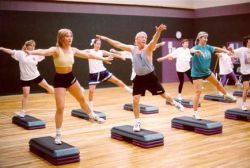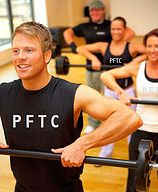Types Of Exercises

Aerobic Exercises: Aerobic exercise is commonly thought to be far more technical than it actually is. Aerobic exercise is simply any type of movement that gets your heart pumping or increases your intake of oxygen. While performing aerobic exercise, the body is repeatedly moving, and in doing so, exercises large muscle groups in the legs, arms and hips. Your aerobic fitness is judges by how well your heart, lungs and blood vessels deliver fuel to your body during physical movement. You should aim to sweat lightly and be slightly out of breath to ensure that exercise is aerobic. While exercising aerobically, your blood moves faster around your body to produce more oxygen and energy to sustain the movements. This is great for the heart, which of course has to work harder to get the blood pumping, and each time it beats harder, it is becoming gradually stronger. It is normal to take deep breaths during aerobic exercise, and this in itself helps you take in more oxygen. Lower intensity activities like walking, running, swimming or cycling actually require a great deal of oxygen to provide the energy needed to prolong them. While you may find it tiring at the time, in the long run aerobic exercise can dramatically improve your stamina, allowing you to exercise longer and better in the future. Aerobic exercise help to rid your body of excess waste products, such as lactic acid, by stimulating the muscle capillaries, and ward off viral infections by activating the immune system. Not surprisingly then, aerobic classes are very popular at gyms, and the benefit of attending a class is that the instructor is trained to get the maximum workout from your body for the maximum gain in terms of health. Usually these classes will incorporate a full-body workout, including toning and muscle firming exercises too. Anyone who is a beginner to aerobics should seek professional advice from a qualified aerobics instructor. For most people 30 minutes of aerobic exercise a day is adequate and is the right amount of time to begin to see improvements in fitness within a few weeks.

Anaerobic Exercise:
Anaerobic exercise, essential for muscle definition and strength building, differs from aerobic exercise in the way we use our oxygen. Anaerobic means ‘without oxygen’; aerobic means ‘with oxygen’. Anaerobic exercise means moving at a faster pace or using greater amounts of energy. Usually this is put into practice with higher intensity and shorter duration bursts, and it helps to burn fat. Anaerobic exercise is not suitable for everyone, particularly those with an illness or heart condition, and is more appropriate for those with a higher fitness level looking to bulk up muscles, although any good fitness routine will use a proportion of both aerobic and anaerobic exercise. Heavy weightlifting, sprinting (rather than running), and jumping are all anaerobic, and they are high producers of a substance called lactic acid. Lactic acid contributes to muscle fatigue, which means that by their very nature, anaerobic exercises cannot last long before recovery time is needed. Although experts say that anaerobic exercise burns fewer calories overall, it is better at building strength and muscle mass, while at the same time having benefits to the heart and lungs. A person with higher muscle mass is more able to become leaner and lose weight because muscle exercises use a larger amount of calories. Those who are anaerobically fit are able to have a higher calorie consumption, an increased metabolism (meaning that they burn their calorie intake more quickly) and are able to have shorter and more effective workouts. Anaerobic exercise should be done initially with a qualified instructor or trainer as there is a higher risk of injury if not done correctly. The types of anaerobic exercise you should be aiming to do include bench presses, arm curls and weight training, stomach (or ab) crunches. It’s also important to vary your routine; muscles become used to routine, and the same number of crunches become less effective over time. Anaerobic exercise is one of the few forms in which ‘working to failure’ is acceptable1 This approach is often used by athletes or weightlifters where they continue to exercise or lift until they are unable to do one more repetition. Initially, you may find that you can only exercise anaerobically for a very short period of time before your muscles become tired. But over time your level of ability will increase, as will your muscle-building and calorie-building abilities. Naturally, with high-density activities such as weight training, there are a number of health and safety issues to consider. Always seek advice from a professional at a reputable gym before embarking on this kind of exercise.